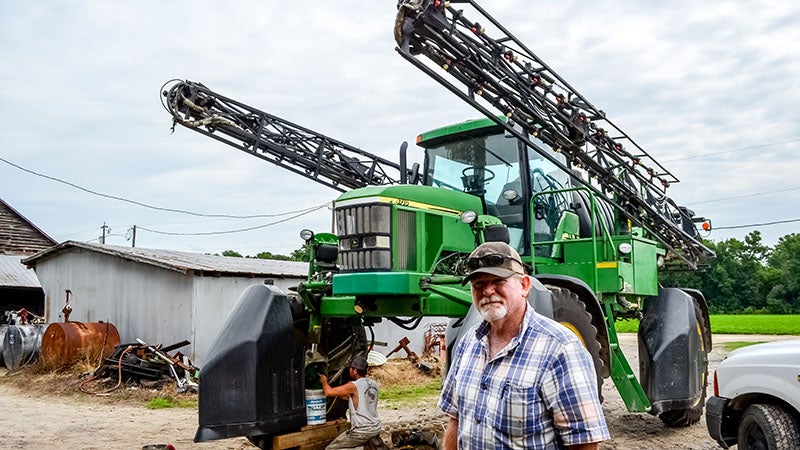‘Up and down’ weather for farmers
Published 9:27 pm Tuesday, June 26, 2018

- David Bosselman works on a John Deere sprayer with his son Hunter at the family’s Old Myrtle Road farm Tuesday morning.
David Bosselman and his son, Hunter, were underneath a John Deere sprayer at their Old Myrtle Road farm Tuesday morning with tools and a blackened rag. The vehicle needed a new O-ring for the hydraulic hose connected to the front right tire, but it was a tight squeeze for both the wrench and the man holding it.
“If they had made this assembly here just a little bit bigger, then you could get a wrench in there to work on it,” Bosselman said as he and his son got their hands dirty in the mild, overcast morning.
The vehicle’s 90-foot-wide spray will spread weed killer on the crops before fungicides and pesticides are added to the mix. Then they’ll bring out the cotton picker machine to cut back any overgrowth that could stymie fruiting this season.
“It’s the same thing with peanuts,” Bosselman said. “If the peanuts end up getting too big, then you’ll end up with less peanuts than if they were a bit smaller. You can put plant growth regulator on peanuts and cotton to regulate that.”
Bosselman’s farm is one of 44,800 in Virginia, according to the Virginia Department of Agriculture and Consumer Services, where agriculture counts for $70 billion annually and provides more than 334,000 jobs.
Farmers in Suffolk have been dealing with another year of rollercoaster weather in May and June, from cold rain and cold to the heat index cracking 100 degrees.
Al Whitener, who also farms in the Myrtle area, saw the erratic months take a toll on his asparagus. He finished harvesting the crop in mid-May but only had about one-fourth of the typical yield in recent years.
“It was a combination of minus-4-degree days, then warming up and then cold rain coming in after that,” Whitener said in a phone interview. “It was just up-and-down weather.”
The farm’s elephant garlic crops fared well, with more than 3,000 garlic bolts drying in the barn. Whitener and his family will spend the summer cutting grass, loading barley into the pond to kill the algae and planting sunflowers and buckwheat for cover crop.
“The bees really like the buckwheat, so it’s a win-win there,” he said.
Shelley Barlow, who farms in the Chuckatuck area, said the family’s corn and cotton were completely planted as of June 12, along with most of the soybeans. Cotton, corn and soybeans planted in the spring will be ready to harvest in the fall.
The May rain was similar to last year’s ordeals, she said, but the cold and the high heat that followed made a big difference.
“Once everything is planted, we’re switching to maintenance,” she said in a phone interview. “Spraying for bugs and weeds and adding more fertilizer. We’re in the taking care of things stage now.”
Some of the crops at Bosselman’s farm wilted last week from the heat, and the ground moisture was getting sparse in the top soil, according to rain gauges. But the peanuts were looking healthy and growing fast.
August is critical for peanuts, cotton and soybeans, Bosselman said, but they have to get through July first. It’s a critical stage for corn, and more moisture around July 4 would be ideal.
Not too much rain, but not too little either, especially since it’s been summer for less than a week and Suffolk has already seen triple-digit temperatures, he said.
“It’s going to be a long, hot summer,” he said. “My granddaddy would say that you’re just 10 days away from a drought when you’ve got those kinds of temperatures.”






